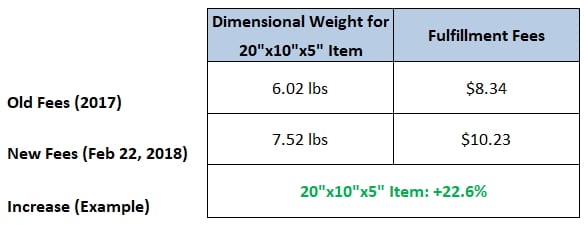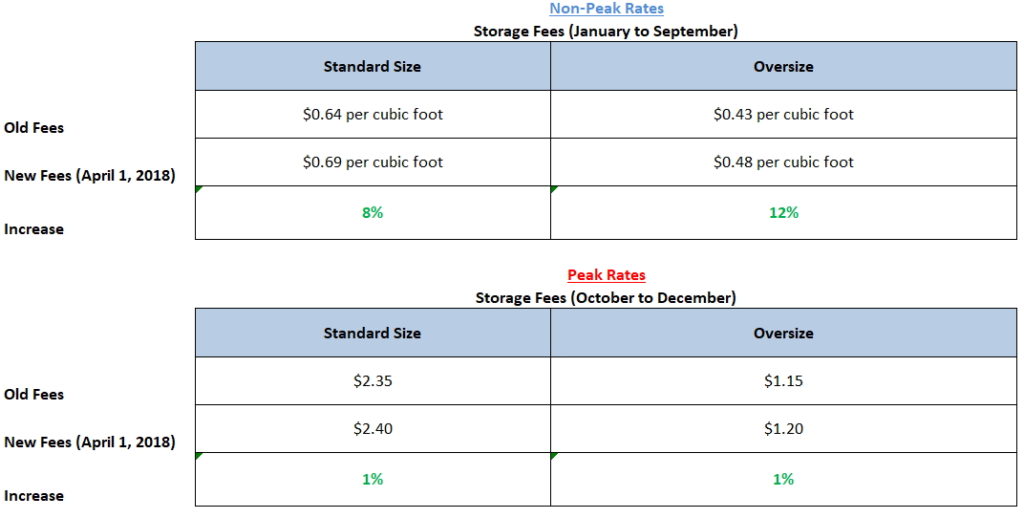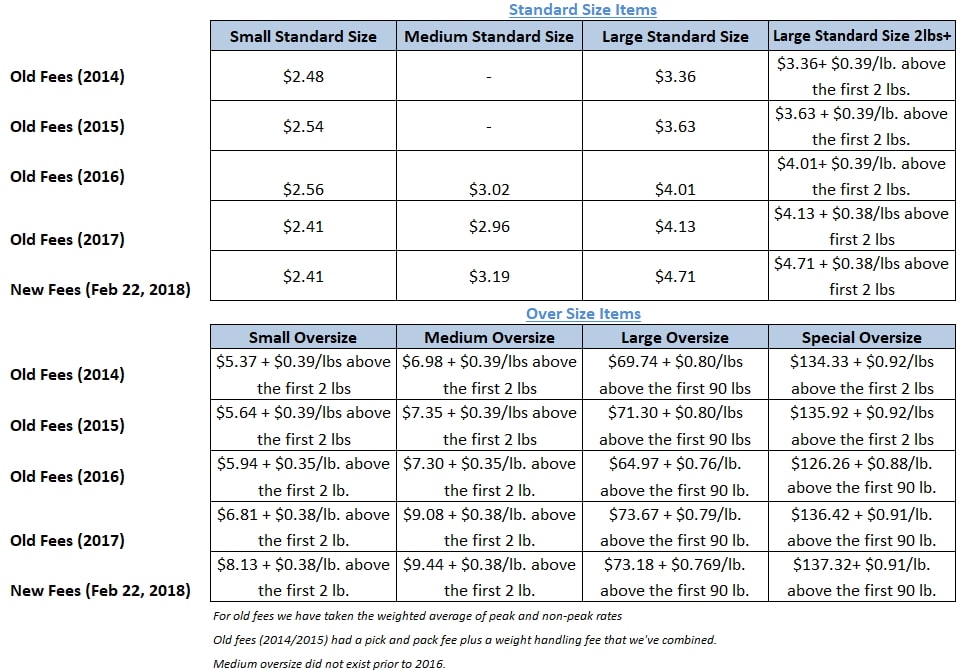Amazon FBA’s Largest Ever Fee Increase Coming in 2018 – How Will it Affect You?
Updated December 19, 2018: See Amazon's 2019 Fee increases.
Updated: March 5, 2018 with Amazon's new storage fees.
Each year around Christmas Amazon brings millions of people joy throughout America with the joy of cheap Christmas gifts for all. And each year they bring terror to Amazon Sellers – Amazon FBA fee increases.
Amazon has just announced their new FBA fee increases effective February 22, 2018. As seems to be predictable with such fee increases, Amazon has structured the fee increases (either deliberately or not) so that the fee structure for 2018 cannot be easily compared to 2017 fees. We'll break down these fee increases objectively and tell them what they mean for your business.
Related Reading: Amazon Selling & FBA Fees Calculator (and How to Save on Fees)
Summary of Changes
- Increases on fulfillment fees for almost all size categories, with Large Standard Size increasing 14.2% and Small Oversize increasing 16.6%
- The dimensional weight divisor has been changed from 166 to 133
- No more peak and non-peak fulfillment rates
- No storage fee increases right now (these will be announced separately early in 2018)
The big news is that Amazon has increased fulfillment fees almost across the board for all size categories. Last year there was actually a mix of price decreases and increases depending on the size category of your item. Not this time around. No one is being spared.
Amazon has also decreased their divisor when calculating dimensional weight meaning that if your products are dim-weighted you're going to pay significantly more.
In the spirit of last year's changes, Amazon is also simplifying the fee structure a bit. Amazon has gotten rid of peak and non-peak fulfillment rates (but it has kept in place peak and non-peak storage rates). This means you will be charged the same fulfillment rates no matter if it's December or June.
Who's Getting Screwed and Who Isn't?
Major Fee Increases
- Anyone shipping Large Standard Size and Small Over Size Items: they're respectively getting, on average, a 14.2% and 16.6% increase
- Medium Standard Size and Large Standard Size (2lbs+) items are respectively getting, om average, a 7.7% and 11% increase
- Items which are dim weighted (have a dimensional weight used instead of actual weight): these will respectively get, on average, a 22.6% increase
Minimal Fee Increases
- Small Standard Size, Medium Oversize, Large Oversize and Special Oversize are relatively unchanged
Amazon is essentially targeting heavier and larger items. Smaller items and very large items (that often need to go LTL truck freight) are relatively unchanged. Unfortunately, it's likely that the majority of readers of this blog will find themselves in the former category.
Fee Increases: Standard Size Items
Aside from the very smallest Standard Size items, every Standard Size item is seeing a significant increase, especially the largest Standard Size Items. As a reminder, a Standard Size item is an item that does not exceed the following dimensions:
- 18″ on its longest side
- 14″ on its median side
- 8″ on its shortest side
- 20 lbs
Any item not meeting these requirements is deemed oversize.
Please note, we have taken a weighted average (peak rates plus non-peak rates) for all of the old fees to take into account Amazon's elimination of peak and non-peak rates.

Fee Increases: Oversize Items
If you're shipping anything Small Oversize you are being severely punished: you will face increases of 16% or above.
Fee Increases: Dimensional Weight
Items which are being dim weighted are being penalized very heavily by Amazon. As a reminder, dimensional weight is calculated as (Length x Width x Height)/133 (formally this was divided by 166). This is a penalty for especially bulky items.
Amazon has changed their divisor from 166 to 133 which will result in, on average, around a 25% increase in the dimensional weight of your item. To be fair to Amazon, many couriers are also changing their divisor. If you don't already know which of your items are dim weighted you need to figure this out.
Amazon Storage Fees Changes
After this article initially got posted, Amazon announced their storage fee increases as well. For standard size items, storage rates are increasing by 8% and for oversize items rates are increasing by 12%. This might not sound like a lot but consider that this already works out to over $45 per month per pallet when your typical third party logistics company charges around $15-25.
Changes to Long Term Storage
Amazon also changed the way it charges for long term storage. It now calculates long term storage on a monthly, instead of a semi-annual basis. Amazon's timing was unfortunate and ironic as I had just finished writing something in one of our paid courses about how to time shipments to get 364 days of storage before being charged long-term storage. Many people, while deliberate or not, we're getting somewhere between 7-11 months of storage before long term storage took effect.
This new policy will only affect people with extremely high inventory turn over times. The truth of the matter is that items sitting in inventory for over 6 months are not just bad for Amazon but also bad for sellers as cash flow is a big part of the Amazon game.
Amazon Historical Fee Increases from 2014-2018
We compiled a table showing all of Amazon FBA fee increases from 2014. As we can see from this table, this latest round of fee increases will be the largest in at least five years for Amazon (and we've yet to see how big the storage fee increases will be).
What You Can Do
- Figure out immediately which of your items are dim weighted and which are not
- Review your packaging and try to make your packaging smaller whenever possible
- Review the margin impact to your products; make price increases as necessary
- Be prepared for storage fee increases in early 2018
- Brace yourself for more increases in 2019
The first thing you need to do is determine if you have any items that are dim weighted or not. You should have a spreadsheet with all of your products and all of the critical data for these items, including their dimensions. If you do, then you can easily create a formula that determines the dimensional weight of your items and compare it to the actual weight. If you don't have such a spreadsheet, then now is a good time to create one.
Second, you should review your packaging and see if there are any opportunities to make the packaging more efficient. The price of cardboard has gone up enormously in China recently due to the pollution controls so you will benefit twice over if you can minimize your packaging.
Finally, calculate how the new price changes will affect your margins. For me, I determined that my average Fulfillment Fees will go from $7.36 to $8.08. Your fees have probably changed by a similar amount. It's easy to ignore a $0.72 increase. However, assuming I sell 1000 items a month that $0.72 change works out to $8,655.54 in additional expenses. The year end is a good time to review all of your margins and consider making price increases.
Conclusion
Amazon FBA fee increases are becoming normal each year. As Amazon costs increase, they expand into more expensive warehouses, and possibly shareholders become restless with razor thin margins, these fee increases can likely be expected for the foreseeable future. Be prudent about these changes and don't become the frog that has the heat turned up on them without noticing the increases. Adjust your pricing and margins to reflect these new prices.
How will your business be affected by the new pricing increases? Are your fees increasing by more than 10%? Share your experiences in the comments section below.








Thanks for the thorough review of these changes, Dave! On a positive note, this will light a fire under a lot of sellers like myself who don’t make enough time during the year to review fees, packaging and margins for their full catalog. As Amazon becomes more expensive, devoting time and capital to building in-house brands and revenue on other sales channels becomes more palatable, leading to healthier businesses overall. On the downside, Amazon only continues to grow, low-cost and lightweight durable packaging is often not as environmentally friendly, and for retailers representing big-name manufacturers, there’s next to no control over pricing, packaging, or product development. We’re never without a challenge in this industry, or a reward shining in the distance.
Yup! The only constant is change. And I never considered the environmental impact of cheap packaging (often plastic).
Thanks for taking the time to provide such a detailed review of the Amazon FBA fee increases for 2018. When I read the announcement from Amazon, it was difficult to actually determine how much my fees were going to change. Your article cleared it up.
Hi Brian,
Yes, I Amazon does a good job of making the fee changes difficult to absorb. Hopefully this helped :)